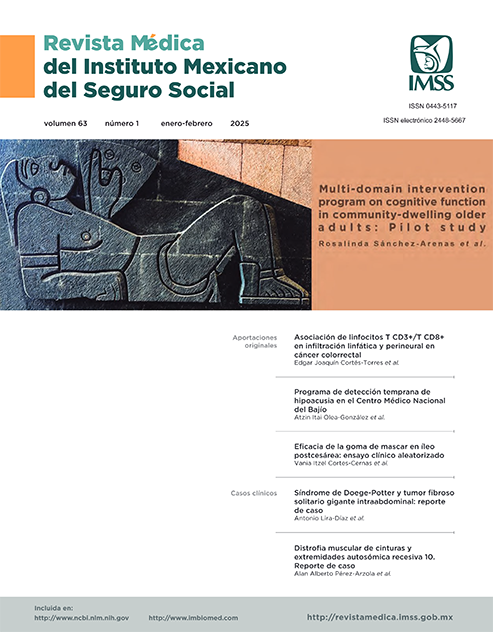Distrofia muscular de cinturas y extremidades autosómica recesiva 10. Reporte de caso
##plugins.themes.themeEleven.article.main##
Palabras clave
Conectina, Distrofias Musculares, Distrofia Muscular de Cinturas, Enfermedades Musculares, Debilidad Muscular
Resumen
Introducción: la distrofia muscular de cinturas y extremidades autosómica recesiva 10 (LGMDR10) es una distrofia muscular causada por variantes patogénicas en el gen TTN que codifica la proteína titina, la cual es responsable de la flexibilidad y la tensión muscular. Su prevalencia es desconocida. Las principales manifestaciones clínicas son debilidad muscular proximal de predominio en la cintura escapular y pélvica, leve debilidad de músculos distales y atrofia muscular. El objetivo es presentar un reporte de caso de distrofia muscular de cinturas y extremidades autosómica recesiva 10 en un paciente mexicano.
Caso clínico: hombre de 39 años con hipotrofia de pierna izquierda, debilidad muscular de las 4 extremidades de predominio proximal y asimétrica, mialgias y calambres nocturnos. La creatinfosfoquinasa total fue de 819.7 UI/L, la velocidad de conducción nerviosa y la electromiografía presentó neuropatía femoral izquierda del tipo axonotmesis y neuropatía mixta axonal con patrón miopático de miembros superiores. El estudio molecular para distrofias musculares reportó 2 variantes patogénicas en estado heterocigoto compuesto en el gen TTN: c.107578C>T (p. Gln37860*) y c.104269C>T (p. Gln34767*), respectivamente.
Conclusiones: conforme a la información disponible, no existen casos reportados de LGMDR10 en México. Esta es una enfermedad progresiva con pérdida total de la deambulación entre la cuarta y la sexta década de vida, por lo que es importante su sospecha clínica para un diagnóstico oportuno, un asesoramiento adecuado y la prevención de complicaciones para una mejor calidad de vida.
Referencias
Udd B, Vihola A, Sarparanta J, et al. Titinopathies and extension of the M-line mutation phenotype beyond distal myopathy and LGMD2J. Neurology. 2005;64(4):636-42. doi: 10.1212/01.WNL.0000151853.50144.82
Rich KA, Moscarello T, Siskind C, et al. Novel heterozygous truncating titin variants affecting the A-band are associated with cardiomyopathy and myopathy/muscular dystrophy. Mol Genet Genomic Med. 2020;8(10):e1460. doi: 10.1002/mgg3.1460
Bouchard C, Tremblay JP. Limb-Girdle Muscular Dystrophies Classification and Therapies. J Clin Med. 2023;12(14):1-15. doi: 10.3390/jcm12144769
Chen Q, Zheng W, Xu H, et al. Digenic Variants in the(espacio)TTN(espacio)and(espacio)TRAPPC11(espacio)Genes Co-segregating With a Limb-Girdle Muscular Dystrophy in a Han Chinese Family. Front Neurosci. 2021;15:601757. doi: 10.3389/fnins.2021.601757
Reyes L, Villamar P, Espinosa N. Distrofia muscular de cinturas 2J, revisión bibliográfica y reporte de un caso pediátrico en Ecuador.(espacio)Metro Ciencia. 2020;(espacio)28(3):8-13. doi: 10.47464/MetroCiencia/vol28/3/2020/8-13
Georganopoulou DG, Moisiadis VG, Malik FA, et al. A Journey with LGMD: From Protein Abnormalities to Patient Impact. Protein J. 2021;40(4):466-88. doi: 10.1007/s10930-021-10006-9
Lombardo ME, Carraro E, Sancricca C, et al. UILDM (Italian Muscular Dystrophy Association) and Italian Consensus Conference Group on motor rehabilitation in muscular dystrophy. Management of motor rehabilitation in individuals with muscular dystrophies. 1st(espacio)Consensus Conference report from UILDM - Italian Muscular Dystrophy Association (Rome, January 25-26, 2019). Acta Myol. 2021;40(2):72-87. doi: 10.36185/2532-1900-046
Morishima R, Schoser B. A Straightforward Approach to Analyze Skeletal Muscle MRI in Limb-Girdle Muscular Dystrophy for Differential Diagnosis: A Systematic Review.(espacio)Muscles.(espacio)2023;2:374-388. doi: 10.3390/muscles2040029 (espacio)
De Paepe B, Velghe E, Salminen L, et al. Diagnostic muscle biopsies in the era of genetics: the added value of myopathology in a selection of limb-girdle muscular dystrophy patients. Acta Neurol Belg. 2021;121(4):1019-33. doi: 10.1007/s13760-020-01559-0
Li C, Haller G, Weihl CC. Current and Future Approaches to Classify VUSs in LGMD-Related Genes. Genes (Basel). 2022;13(2):382. doi: 10.3390/genes13020382
Straub V, Murphy A, Udd B. 229th ENMC international workshop: Limb girdle muscular dystrophies - Nomenclature and reformed classification Naarden, the Netherlands, 2018;28(8):702-10. doi: 10.1016/j.nmd.2018.05.007
Savarese M, Vihola A, Oates EC, et al. Udd B. Genotype-phenotype correlations in recessive titinopathies. Genet Med. 2020;22(12):2029-40. doi: 10.1038/s41436-020-0914-2
Savarese M, Sarparanta J, Vihola A, et al. Increasing Role of Titin Mutations in Neuromuscular Disorders. J Neuromuscul Dis. 2016;3(3):293-308. doi: 10.3233/JND-160158
Misaka T, Yoshihisa A, Takeishi Y. Titin in muscular dystrophy and cardiomyopathy: Urinary titin as a novel marker. Clin Chim Acta. 2019;495:123-8. doi: 10.1016/j.cca.2019.04.005
Nigro V, Savarese M. Genetic basis of limb-girdle muscular dystrophies: The 2014 update. Acta Myol. 2014;33(1):1-12.
Leońska-Duniec A, Borczyk M, Piechota M, et al. TTN(espacio)Variants Are Associated with Physical Performance and Provide Potential Markers for Sport-Related Phenotypes. Int J Environ Res Public Health. 2022;19(16):10173. doi: 10.3390/ijerph191610173
Chen Q, Zheng W, Xu H, et al. Digenic Variants in the TTN and TRAPPC11 Genes Co-segregating With a Limb-Girdle Muscular Dystrophy in a Han Chinese Family. Front Neurosci. 2021;15:601757. doi: 10.3389/fnins.2021.601757
Loescher CM, Hobbach AJ, Linke WA. Titin (TTN): from molecule to modifications, mechanics, and medical significance. Cardiovasc Res. 2022;118(14):2903-18. doi: 10.1093/cvr/cvab328
Jolfayi AG, Kohansal E, Ghasemi S, et al. Exploring TTN variants as genetic insights into cardiomyopathy pathogenesis and potential emerging clues to molecular mechanisms in cardiomyopathies. Sci Rep. 2024;14(1):5313. doi: 10.1038/s41598-024-56154-7
Wang G, Lv X, Xu L, et al. Novel compound heterozygous mutations in the TTN gene: elongation and truncation variants causing limb-girdle muscular dystrophy type 2J in a Han Chinese family. Neurol Sci. 2022;43(5):3427-33. doi: 10.1007/s10072-022-05979-z
Rees M, Nikoopour R, Fukuzawa A, et al. Making sense of missense variants in TTN-related congenital myopathies. Acta Neuropathol. 2021;141(3):431-53. doi: 10.1007/s00401-020-02257-0
Pénisson-Besnier I, Hackman P, Suominen T, et al. Myopathies caused by homozygous titin mutations: Limb-girdle muscular dystrophy 2J and variations of phenotype. J Neurol Neurosurg Psychiatry. 2010;81(11):1200-2.
Khan A, Wang R, Han S, et al. Homozygous missense variant in the TTN gene causing autosomal recessive limb-girdle muscular dystrophy type 10. BMC Med Genet. 2019;20(1):166. doi: 10.1186/s12881-019-0895-7
Pozsgai E, Griffin D, Potter R, (espacio)et al. Unmet needs and evolving treatment for limb girdle muscular dystrophies. Neurodegener Dis Manag. 2021;11(5):411-29. doi: 10.2217/nmt-2020-0066


